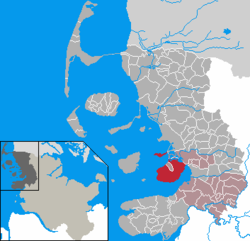geo.wikisort.org - Coast
![]() Nordstrand (help·info) (North Frisian: di Ströön[2]) is a peninsula and former island in North Frisia on the North Sea coast of Germany. It is part of the Nordfriesland district in the federal state of Schleswig-Holstein. Its area is 50 km² and its population is 2,300. Nordstrand has two municipalities, Nordstrand and smaller Elisabeth-Sophien-Koog, which are part of the Amt Nordsee-Treene.
Nordstrand (help·info) (North Frisian: di Ströön[2]) is a peninsula and former island in North Frisia on the North Sea coast of Germany. It is part of the Nordfriesland district in the federal state of Schleswig-Holstein. Its area is 50 km² and its population is 2,300. Nordstrand has two municipalities, Nordstrand and smaller Elisabeth-Sophien-Koog, which are part of the Amt Nordsee-Treene.
Nordstrand di Ströön | |
|---|---|
Municipality | |
 | |
Location of Nordstrand di Ströön within Nordfriesland district  | |
 Nordstrand di Ströön  Nordstrand di Ströön | |
| Coordinates: 54°29′0″N 8°53′0″E | |
| Country | Germany |
| State | Schleswig-Holstein |
| District | Nordfriesland |
| Municipal assoc. | Nordsee-Treene |
| Government | |
| • Mayor | Jens-Johann Jacobsen (CDU) |
| Area | |
| • Total | 57.43 km2 (22.17 sq mi) |
| Elevation | 2 m (7 ft) |
| Population (2020-12-31)[1] | |
| • Total | 2,237 |
| • Density | 39/km2 (100/sq mi) |
| Time zone | UTC+01:00 (CET) |
| • Summer (DST) | UTC+02:00 (CEST) |
| Postal codes | 25845 |
| Dialling codes | 04842 |
| Vehicle registration | NF |
| Website | www |
In medieval times Nordstrand was a part of the larger island of Strand, which was torn into pieces in a disastrous storm tide in 1634. More than 6,000 people drowned. Before 1634 the area of the island was about 210 square miles (540 km2).[3] Other remnants of Strand are Pellworm and some Halligen islets.
Nordstrand is accessible by road over a causeway, which connects to the mainland and was built in 1936. In 1987 the polder Beltringharder Koog was completed, turning the former island into a peninsula.
Local alcoholic beverage
Nordstrand is the origin of a locally famous alcoholic beverage, the Pharisäer (Pharisee), which the islanders developed in 1872 to be able to drink alcohol in the presence of local pastor Georg Bleyer, who preached abstinence. It is made from hot strong coffee, sugar, dark rum (4 cl of 54% vol.) and whipped cream (to prevent the alcohol from evaporating, so that it could not be smelled). The pastor got the only cup without rum, but one day the cups got mixed up. When he discovered the deceit he exclaimed "Ihr Pharisäer!" ("You Pharisees!", connoting: "hypocrites"). Hence the name.[4][5]
North American emigrants who used it as a surname
The original Nordstrand island (before the flood of 1634) is thought to be the ancestral homeland of the North American surname ‘van Nostrand’ (including variants: vanNostrand, vanNordstrandt, vanOstrand). Two brothers emigrated from here to what is now New York, USA, in 1637 and 1638 after the flood. One of the three granite panels of the Canadian van Nostrand monument, in York Mill's Cemetery, Toronto (St John’s, York Mills, Anglican Church, 19 Don Ridge Dr., North York, Toronto, Ontario), points to Nordstrand Island.
Pieter Karstense van Nortstrant was born about 1605 on the island of Norstrand. Coupled with the name of his father, Carsten or Kersten, and the fact that his children were baptized in the Lutheran Church in Amsterdam, it would seem that a German, Frisian or Danish origin is probable. It is uncertain when Pieter Karstense came to Amsterdam, possibly as a child with his father, though no record of the latter has been found there. The sons of Pieter Pietersen Ostrander (son of Pieter Karstense van Nortstrant) were called Van Norstrande or Van Nostrande, whilst Van Ostrande was used in other baptisms and eventually became the surname Oostrander and then the spelling as it is today, Ostrander.[6]
Characters from Nordstrand
- Ludwig Ingwer Nommensen, was a German Lutheran missionary to North Sumatra who also translated the New Testament into the native Batak language.
- Peter Harry Carstensen, prime minister of the state of Schleswig-Holstein from 2005 until 2012.
See also
- Jan Adriaanszoon Leeghwater, Dutch hydraulic engineer
References
- "Statistikamt Nord – Bevölkerung der Gemeinden in Schleswig-Holstein 4. Quartal 2020 (XLS-file)". Statistisches Amt für Hamburg und Schleswig-Holstein (in German).
- Nordfriesland-Karte, Nordfriisk Instituut, Bräist/Bredstedt 2011, ISBN 978-3-88007-371-5
- Rines, George Edwin, ed. (1920). . Encyclopedia Americana.
- Jysk Ordbog[permanent dead link] (in Danish)
- Jyllands-Posten Archived 2006-11-17 at the Wayback Machine which dates this event to 1873 (in Danish)
- "PATRONYMICS AND SURNAMES". Ostrander Family Association. Retrieved 5 June 2012.
External links
- Integrated Landscape and Cultural Heritage Management and Development Plan for the Wadden Sea Region
На других языках
- [en] Nordstrand, Germany
[it] Nordstrand
Nordstrand (nella variante locale del frisone: Noordströön) è una delle isole Frisone Settentrionali sulla costa tedesca del Mare del Nord. L'isola fa parte del distretto della Frisia Settentrionale nel Bundesland (stato federale) dello Schleswig-Holstein. Copre un'area di 46,60 km² e conta una popolazione di circa 2 300 persone.[ru] Нордштранд
Нордштранд (нем. Nordstrand) — община в Германии, в земле Шлезвиг-Гольштейн.Другой контент может иметь иную лицензию. Перед использованием материалов сайта WikiSort.org внимательно изучите правила лицензирования конкретных элементов наполнения сайта.
WikiSort.org - проект по пересортировке и дополнению контента Википедии

